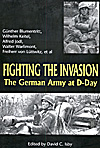 Greenhill Books, 2000, £ 19.95, ISBN 1-85367-427-3, 256 pages
Greenhill Books, 2000, £ 19.95, ISBN 1-85367-427-3, 256 pages
By Gunther Blumentritt, Wilhelm Keitel, Alfred Jodl, Walter Warlimont, Freiherr von Luttwitz, et al.
Anyone interested in the D-Day invasion of Normandy should get this book. I can't tell you how many times I read and re-read sections of this book. Essentially, this is a compilation of contemporary excerpts written by various German Commanders.
Part Two (Organizing and Deploying the Units) is the best portion as it examines each German unit in excruciating detail. You'll find a wealth of TO&E information that helps explain successes and failures during the invasion. Add in commander commentary and other insights, and you'll be going back to this volume over and over again.
Close behind in usefulness and interest is Part Three: D-Day Invasion. This takes you through the events on June 6, 1944. Again, these are primarily from reports filed at the time or shortly thereafter by Generals down to Majors--and you can see the difference in thought and priorities as you go lower in the command structure.
Part IV deals with the counterattack and has moments of insight, but some seem a tad inadequate and brief. Part I: Preparations Commands and Commanders tackles deployments and supply and has good points and bad.
The book contains a plethora of maps showing positions and movements. Maps are always difficult to find and Greenhill is to be complimented for including 10 maps (and 25 black and white photos).
Bits and pieces of this work really present new information, even if anecdotally.
"Replacements consisted chiefly of young people (class of 1925/26). Almost all these people, being physically of limited capacity as a result of the shortage of food in Germany, were fit only for limited military duties. Marches over 15 kilometers led to high casualties. A proposal of the division to grant these people a milk allowance was ignored. The purchase of milk from the country, in which the French peasantry was very helpful, succeeded in correcting the dietary deficiency of these young people." [p. 123]
"Order of Combat Efficiency (panzer-type Divisions)
A: 2nd Panzer, 9th SS Panzer, 12th 55 Panzer, Panzer Lehr
B: 11th Panzer, 2nd SS Panzer, 21st Panzer
C: 9th Panzer, 17th SS Panzer Grenadier, 116th Panzer (probably)
D: 10th Panzer, 1st SS Panzer
(estimate is of 6 June 1944, no matter what performance the divisions made later on)." [p. 96]
Note: a remarks section describes why each division is considered A,B,C,& D.
It's just these types of contemporary bits and pieces that make this a fascinating work.
More
Isby continues his archive spelunking in Fighting in Normandy, which covers the next week of combat.
Back to List of Book Reviews: World War II
Back to Master List of Book Reviews
Back to Master Magazine List
© Copyright 2000 by Coalition Web, Inc.
This article appears in MagWeb (Magazine Web) on the Internet World Wide Web.
Other military history articles and gaming articles are available at http://www.magweb.com